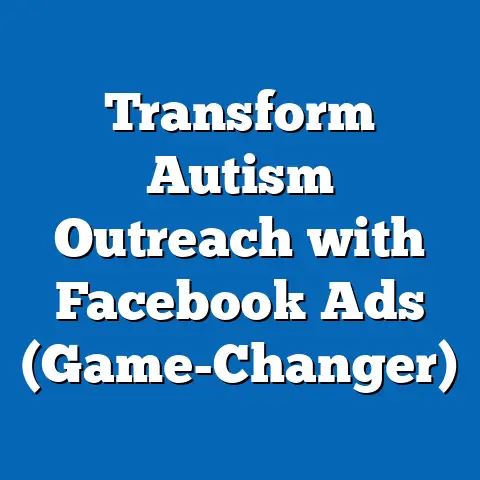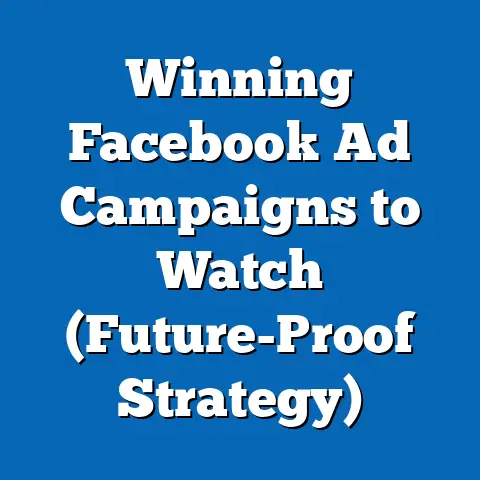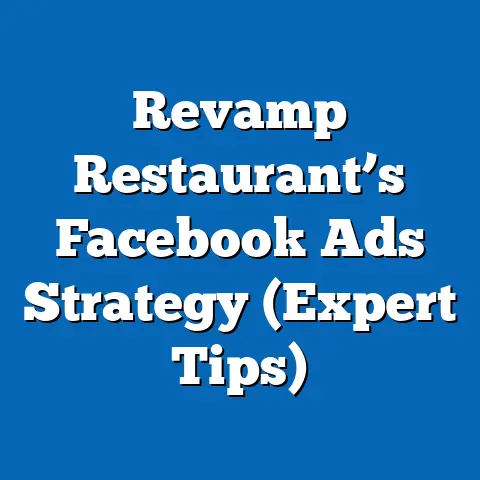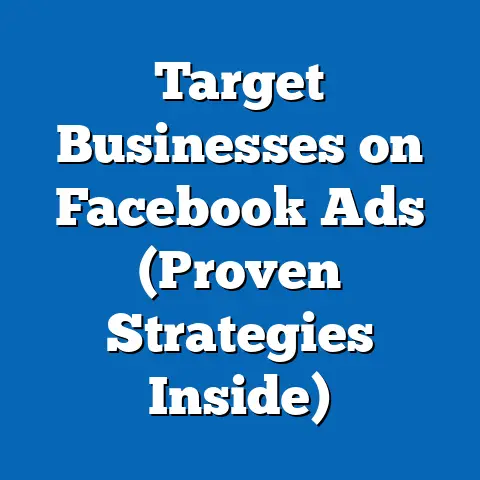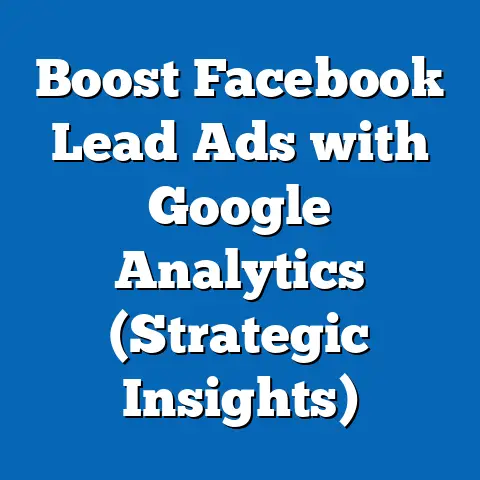Transforma Anuncios con Facebook Ads (Elevate ROI)
In today’s digital age, Facebook reigns supreme as a social media giant, boasting billions of active users who spend a significant portion of their day engaging with content on the platform. As a digital marketing expert, I’ve witnessed firsthand the immense potential Facebook holds for businesses looking to connect with their target audience and drive meaningful results. However, simply launching ads on Facebook isn’t enough. To truly succeed and achieve a high return on investment (ROI), you need to transform your advertising strategies and leverage the platform’s capabilities to their fullest potential.
Comprender Facebook Ads
Facebook Ads are a powerful tool that allows businesses to reach a vast and diverse audience within the Facebook ecosystem. Unlike traditional advertising methods, Facebook Ads offer unparalleled targeting capabilities, enabling you to connect with potential customers based on their demographics, interests, behaviors, and more.
Think of Facebook Ads as a highly customizable billboard that can be displayed to specific individuals who are most likely to be interested in your products or services. This targeted approach not only increases the effectiveness of your advertising campaigns but also helps you optimize your budget by ensuring that your ads are seen by the right people.
Different Types of Facebook Ads:
Facebook offers a variety of ad formats to suit different objectives and creative approaches. Here are some of the most common types of Facebook Ads:
- Image Ads: Simple yet effective, image ads feature a single image or video accompanied by text. They are ideal for showcasing your products or services and creating a visually appealing message.
- Video Ads: Capture attention and tell your story with engaging video ads. Video ads can be used to demonstrate product features, share customer testimonials, or create a brand narrative.
- Carousel Ads: Display multiple images or videos in a scrollable format, allowing you to showcase a range of products, highlight different features, or tell a sequential story.
- Collection Ads: Designed for e-commerce businesses, collection ads feature a main image or video along with a selection of related products. This format allows users to browse and purchase products directly from the ad.
- Lead Ads: Collect valuable leads directly from Facebook users with lead ads. These ads allow users to submit their contact information without leaving the platform, making it easy for you to capture potential customers.
- Instant Experience Ads: Create immersive and interactive experiences with instant experience ads. These full-screen ads load instantly and can include a variety of elements, such as videos, images, carousels, and forms.
Setting Clear Objectives:
Before you start creating your Facebook Ads, it’s crucial to define clear objectives for your campaigns. What do you want to achieve with your ads? Are you looking to increase brand awareness, generate leads, drive sales, or something else?
Your objectives will guide your entire advertising strategy, influencing your ad format, targeting options, and bidding strategy. Here are some common objectives for Facebook Ads:
- Brand Awareness: Increase the visibility of your brand and reach a wider audience.
- Reach: Maximize the number of people who see your ads.
- Traffic: Drive traffic to your website or landing page.
- Engagement: Encourage users to interact with your ads, such as liking, commenting, or sharing.
- Lead Generation: Collect leads from potential customers.
- Conversions: Drive sales or other desired actions on your website or app.
- App Installs: Encourage users to download your mobile app.
By setting clear objectives, you can measure the success of your campaigns and make informed decisions about how to optimize your spending for maximum impact.
Takeaway: Facebook Ads offer a powerful platform for reaching your target audience and achieving your business goals. Understanding the different ad formats and setting clear objectives are essential first steps in transforming your advertising strategy.
Definir tu Público Objetivo
One of the most significant advantages of Facebook Ads is its unparalleled targeting capabilities. Unlike traditional advertising methods, which often rely on broad demographics and limited data, Facebook allows you to pinpoint your ideal customers with incredible precision. This targeted approach ensures that your ads are seen by the people who are most likely to be interested in your products or services, maximizing your ROI.
The Importance of Targeting:
Targeting is the cornerstone of a successful Facebook Ads campaign. By carefully defining your target audience, you can:
- Increase Relevance: Show your ads to people who are genuinely interested in what you have to offer.
- Improve Engagement: Drive higher engagement rates, such as likes, comments, and shares.
- Boost Conversions: Increase the likelihood of converting potential customers into paying customers.
- Reduce Waste: Avoid wasting your budget on showing ads to people who are unlikely to be interested in your products or services.
Using Facebook’s Audience Insights Tool:
Facebook’s Audience Insights tool is a powerful resource for understanding your target audience and identifying potential customers. This tool provides valuable data on demographics, interests, behaviors, and more, allowing you to create highly targeted audiences for your Facebook Ads campaigns.
Here’s a step-by-step guide on how to use Facebook’s Audience Insights tool:
- Access Audience Insights: Navigate to the Facebook Ads Manager and click on “Audience Insights” in the left-hand menu.
- Choose Your Audience: Select whether you want to analyze everyone on Facebook or people who are connected to your page.
- Define Your Criteria: Use the filters on the left-hand side to define your target audience based on demographics, interests, behaviors, and connections.
- Explore the Data: Review the data provided by Audience Insights, including demographics, page likes, location, activity, and household information.
- Create Your Audience: Use the insights you’ve gathered to create a custom audience in Facebook Ads Manager.
Creating Custom and Lookalike Audiences:
In addition to using Facebook’s Audience Insights tool, you can also create custom and lookalike audiences to reach potential customers effectively.
- Custom Audiences: Custom audiences allow you to target people who have already interacted with your business, such as website visitors, email subscribers, or app users. You can upload your customer data to Facebook and create a custom audience based on this information.
- Lookalike Audiences: Lookalike audiences allow you to reach new people who are similar to your existing customers. Facebook analyzes your custom audience and identifies users with similar demographics, interests, and behaviors.
By combining these targeting strategies, you can create highly targeted audiences that are more likely to engage with your ads and convert into paying customers.
Takeaway: Defining your target audience is crucial for maximizing the ROI of your Facebook Ads campaigns. Use Facebook’s Audience Insights tool and create custom and lookalike audiences to reach potential customers effectively.
Crear Anuncios Atractivos
Creating compelling ads is essential for capturing the attention of your target audience and driving meaningful results. In a crowded digital landscape, your ads need to stand out and resonate with potential customers. This section will provide you with tips on crafting compelling ad copy, using high-quality visuals, and incorporating effective calls-to-action (CTAs).
Crafting Compelling Ad Copy:
Your ad copy is your opportunity to communicate your message and persuade potential customers to take action. Here are some tips for crafting compelling ad copy that resonates with your target audience:
- Know Your Audience: Understand your target audience’s needs, wants, and pain points. Tailor your ad copy to address their specific concerns and offer solutions.
- Highlight Benefits: Focus on the benefits of your products or services, rather than just the features. Explain how your offerings can improve your customers’ lives.
- Use Strong Headlines: Your headline is the first thing people will see, so make it count. Use strong, attention-grabbing headlines that pique their interest and encourage them to read more.
- Keep it Concise: People have short attention spans, so keep your ad copy concise and to the point. Get your message across quickly and effectively.
- Use a Clear Call to Action: Tell people what you want them to do. Use a clear and concise call to action that encourages them to click on your ad, visit your website, or make a purchase.
The Importance of High-Quality Visuals:
Visuals play a crucial role in capturing attention and conveying your message. High-quality images and videos can significantly impact the performance of your Facebook Ads. Here are some tips for using visuals effectively:
- Use High-Resolution Images: Use high-resolution images that are clear, crisp, and visually appealing. Avoid using blurry or pixelated images.
- Choose Relevant Images: Choose images that are relevant to your ad copy and target audience. The images should accurately represent your products or services.
- Use Engaging Videos: Videos are a powerful way to capture attention and tell your story. Use engaging videos that are well-produced and visually appealing.
- Test Different Visuals: Experiment with different images and videos to see what resonates best with your target audience. Use A/B testing to compare the performance of different visuals.
- Consider Mobile Optimization: Make sure your visuals are optimized for mobile devices. Many Facebook users access the platform on their smartphones, so your visuals should look good on smaller screens.
Examples of Successful Ad Campaigns:
To illustrate the importance of strong visuals and messaging, let’s look at some examples of successful Facebook Ad campaigns:
- Dove’s Real Beauty Campaign: Dove’s Real Beauty campaign used authentic and relatable visuals to challenge traditional beauty standards. The campaign resonated with women around the world and helped Dove build a strong brand image.
- Airbnb’s Live There Campaign: Airbnb’s Live There campaign used stunning visuals and compelling storytelling to encourage travelers to experience destinations like locals. The campaign helped Airbnb differentiate itself from traditional hotel chains.
- Dollar Shave Club’s Viral Video: Dollar Shave Club’s viral video used humor and wit to promote their subscription service. The video was widely shared on social media and helped Dollar Shave Club disrupt the shaving industry.
The Use of Calls-to-Action (CTAs):
Calls-to-action (CTAs) are essential for driving user engagement and conversions. A CTA is a prompt that tells users what you want them to do next. Here are some examples of effective CTAs:
- Shop Now: Encourage users to make a purchase.
- Learn More: Provide users with more information about your products or services.
- Sign Up: Encourage users to subscribe to your email list or create an account.
- Download Now: Encourage users to download your app or a free resource.
- Contact Us: Encourage users to reach out to your business with questions or inquiries.
Make sure your CTAs are clear, concise, and visually appealing. Use strong verbs and persuasive language to encourage users to take action.
Takeaway: Creating compelling ads is essential for capturing the attention of your target audience and driving meaningful results. Craft compelling ad copy, use high-quality visuals, and incorporate effective calls-to-action (CTAs) to maximize the impact of your Facebook Ads campaigns.
Estrategias de Optimización
Once you’ve launched your Facebook Ads campaigns, the work doesn’t stop there. Optimization is an ongoing process that involves continually monitoring your results, analyzing your data, and making adjustments to improve your performance. This section will outline key strategies for optimizing your Facebook Ads for better performance, including A/B testing, ad placement selection, and budget allocation.
A/B Testing:
A/B testing, also known as split testing, is a powerful technique for comparing different versions of your ads to see which performs better. By testing different headlines, images, ad copy, and CTAs, you can identify the elements that resonate most with your target audience and optimize your ads for maximum impact.
Here’s how to conduct A/B testing on Facebook Ads:
- Create Two Versions of Your Ad: Create two versions of your ad that are identical except for one element that you want to test, such as the headline or image.
- Run the Ads Simultaneously: Run both versions of your ad simultaneously to the same target audience.
- Track the Results: Monitor the performance of each ad, paying attention to metrics such as click-through rate (CTR), conversion rate, and cost per acquisition (CPA).
- Analyze the Data: Analyze the data to determine which version of your ad performed better.
- Implement the Winning Version: Implement the winning version of your ad and continue testing other elements to further optimize your performance.
Ad Placement Selection:
Facebook offers a variety of ad placements, including the Facebook News Feed, Instagram Feed, Audience Network, and Messenger. Each placement has its own unique characteristics and can be more or less effective depending on your target audience and campaign objectives.
Here are some tips for selecting the right ad placements:
- Consider Your Target Audience: Think about where your target audience spends most of their time on Facebook. If your target audience is active on Instagram, you may want to focus on Instagram Feed placements.
- Test Different Placements: Experiment with different ad placements to see which performs best for your campaigns.
- Use Automatic Placements: Facebook’s automatic placements option allows the platform to automatically optimize your ad placements based on performance.
Budget Allocation:
How you allocate your budget can significantly impact the performance of your Facebook Ads campaigns. Here are some tips for optimizing your budget allocation:
- Set a Daily or Lifetime Budget: Choose between setting a daily budget, which allows you to spend a certain amount each day, or a lifetime budget, which allows you to spend a certain amount over the course of your campaign.
- Monitor Your Spending: Regularly monitor your spending to make sure you’re on track to meet your budget goals.
- Adjust Your Bids: Adjust your bids based on performance. If you’re not getting enough impressions or clicks, you may need to increase your bids.
- Pause Underperforming Ads: Pause ads that are not performing well to avoid wasting your budget.
- Reallocate Budget to Top Performers: Reallocate budget to ads that are performing well to maximize your ROI.
Monitoring Analytics and Interpreting Data:
Monitoring analytics and interpreting data is crucial for making informed decisions about how to optimize your Facebook Ads campaigns. Facebook Ads Manager provides a wealth of data on your ad performance, including impressions, clicks, CTR, conversion rate, CPA, and more.
Here are some key metrics to monitor:
- Impressions: The number of times your ad was shown.
- Reach: The number of unique people who saw your ad.
- Clicks: The number of times people clicked on your ad.
- Click-Through Rate (CTR): The percentage of people who saw your ad and clicked on it.
- Conversion Rate: The percentage of people who clicked on your ad and completed a desired action, such as making a purchase or signing up for an email list.
- Cost Per Acquisition (CPA): The cost of acquiring a new customer.
- Return on Ad Spend (ROAS): The revenue generated for every dollar spent on advertising.
By monitoring these metrics and interpreting the data, you can identify areas for improvement and make informed decisions about how to optimize your Facebook Ads campaigns for better performance and higher ROI.
Takeaway: Optimizing your Facebook Ads campaigns is an ongoing process that requires continual monitoring, analysis, and adjustments. Use A/B testing, ad placement selection, and budget allocation strategies to improve your performance and maximize your ROI.
Retargeting y Remarketing
Retargeting and remarketing are powerful strategies for increasing ROI by reaching potential customers who have already interacted with your business. These strategies allow you to show ads to people who have visited your website, viewed your products, or engaged with your content on social media. By targeting these warm leads, you can increase the likelihood of converting them into paying customers.
Understanding Retargeting and Remarketing:
Retargeting and remarketing are often used interchangeably, but there is a subtle difference between the two. Retargeting typically refers to showing ads to people who have visited your website, while remarketing can encompass a broader range of activities, such as sending emails to people who have abandoned their shopping carts.
In the context of Facebook Ads, both retargeting and remarketing involve showing ads to people who have interacted with your business in some way. Here are some common examples of retargeting and remarketing campaigns:
- Website Visitors: Show ads to people who have visited your website but haven’t made a purchase.
- Product Viewers: Show ads to people who have viewed specific products on your website.
- Abandoned Carts: Show ads to people who have added items to their shopping cart but haven’t completed the purchase.
- Email Subscribers: Show ads to people who are subscribed to your email list.
- Social Media Engagers: Show ads to people who have liked, commented, or shared your content on social media.
Setting Up a Retargeting Campaign:
Here’s a step-by-step guide on how to set up a retargeting campaign on Facebook:
- Install the Facebook Pixel: The Facebook Pixel is a snippet of code that you place on your website to track visitor behavior. Install the Facebook Pixel on your website to start collecting data on your website visitors.
- Create a Custom Audience: Create a custom audience based on your website visitors. You can segment your audience based on specific pages they visited, products they viewed, or actions they took on your website.
- Create a Retargeting Ad: Create a retargeting ad that is tailored to your target audience. Use compelling ad copy and visuals that are relevant to their interests and needs.
- Set Your Targeting Options: Set your targeting options to target your custom audience. You can also exclude certain users from your retargeting campaign, such as people who have already made a purchase.
- Monitor Your Results: Monitor your results to see how your retargeting campaign is performing. Adjust your targeting options, ad copy, and visuals as needed to improve your performance.
Case Studies and Examples:
Here are some examples of businesses that have successfully used retargeting to boost their ROI:
- An E-commerce Store: An e-commerce store retargeted website visitors who had viewed specific products but hadn’t made a purchase. By showing these visitors ads featuring the products they had viewed, the store was able to increase its conversion rate by 20%.
- A Subscription Service: A subscription service retargeted website visitors who had signed up for a free trial but hadn’t converted to a paid subscription. By showing these visitors ads highlighting the benefits of the paid subscription, the service was able to increase its conversion rate by 15%.
- A Local Business: A local business retargeted website visitors who had visited its website but hadn’t made an appointment. By showing these visitors ads offering a discount on their first appointment, the business was able to increase its appointment bookings by 10%.
Takeaway: Retargeting and remarketing are powerful strategies for increasing ROI by reaching potential customers who have already interacted with your business. Set up a retargeting campaign on Facebook to show ads to website visitors, product viewers, and other warm leads.
Conclusion
Transforming your ads with Facebook Ads is an ongoing process that requires continual learning, adaptation, and a willingness to experiment. By understanding the platform’s capabilities, defining your target audience, creating compelling ads, optimizing your campaigns, and leveraging retargeting strategies, you can unlock the power of Facebook advertising and elevate your ROI.
Remember, success on Facebook Ads doesn’t happen overnight. It takes time, effort, and a commitment to continuous improvement. But with the right strategies and a data-driven approach, you can achieve your business goals and drive meaningful results on Facebook.
Call to Action
Now it’s your turn to take action. Start implementing the strategies discussed in this article and share your results or experiences in the comments or on social media. I’m eager to hear about your success stories and help you overcome any challenges you may encounter along the way. Let’s transform your Facebook Ads together and elevate your ROI to new heights!

